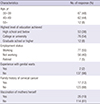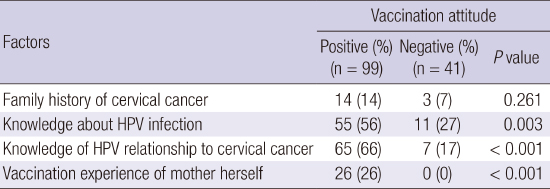1. Lee Y, Lim MC, Kim SI, Joo J, Lee DO, Park SY. Comparison of quality of life and sexuality between cervical cancer survivors and healthy women. Cancer Res Treat. 2016; 48:1321–1329.
2. World Health Organization. Human papillomavirus vaccines: WHO position paper, October 2014. Wkly Epidemiol Rec. 2014; 89:465–491.
3. Han KT, Kim SJ, Lee SY, Park EC. Cost-effectiveness analysis of HPV vaccination: comparing the general population with socially vulnerable individuals. Asian Pac J Cancer Prev. 2014; 15:8503–8508.
4. Kelly BJ, Leader AE, Mittermaier DJ, Hornik RC, Cappella JN. The HPV vaccine and the media: how has the topic been covered and what are the effects on knowledge about the virus and cervical cancer? Patient Educ Couns. 2009; 77:308–313.
6. Elam-Evans LD, Yankey D, Jeyarajah J, Singleton JA, Curtis RC, MacNeil J, Hariri S; Immunization Services Division, National Center for Immunization and Respiratory Diseases. Centers for Disease Control and Prevention (CDC). National, regional, state, and selected local area vaccination coverage among adolescents aged 13-17 years--United States, 2013. MMWR Morb Mortal Wkly Rep. 2014; 63:625–633.
7. Davis K, Dickman ED, Ferris D, Dias JK. Human papillomavirus vaccine acceptability among parents of 10- to 15-year-old adolescents. J Low Genit Tract Dis. 2004; 8:188–194.
8. Kessels SJ, Marshall HS, Watson M, Braunack-Mayer AJ, Reuzel R, Tooher RL. Factors associated with HPV vaccine uptake in teenage girls: a systematic review. Vaccine. 2012; 30:3546–3556.
9. Laz TH, Rahman M, Berenson AB. An update on human papillomavirus vaccine uptake among 11-17 year old girls in the United States: National Health Interview Survey, 2010. Vaccine. 2012; 30:3534–3540.
10. Dahlström LA, Tran TN, Lundholm C, Young C, Sundström K, Sparén P. Attitudes to HPV vaccination among parents of children aged 12-15 years-a population-based survey in Sweden. Int J Cancer. 2010; 126:500–507.
11. Mullins TL, Griffioen AM, Glynn S, Zimet GD, Rosenthal SL, Fortenberry JD, Kahn JA. Human papillomavirus vaccine communication: perspectives of 11-12 year-old girls, mothers, and clinicians. Vaccine. 2013; 31:4894–4901.
12. Hertweck SP, LaJoie AS, Pinto MD, Flamini L, Lynch T, Logsdon MC. Health care decision making by mothers for their adolescent daughters regarding the quadrivalent HPV vaccine. J Pediatr Adolesc Gynecol. 2013; 26:96–101.
13. Reiter PL, McRee AL. Correlates of receiving recommended adolescent vaccines among youth with special health care needs: findings from a statewide survey. Vaccine. 2016; 34:3125–3131.
14. McRee AL, Gottlieb SL, Reiter PL, Dittus PJ, Tucker Halpern C, Brewer NT. Human papillomavirus vaccine discussions: an opportunity for mothers to talk with their daughters about sexual health. Sex Transm Dis. 2012; 39:394–401.
15. Gilkey MB, Magnus BE, Reiter PL, McRee AL, Dempsey AF, Brewer NT. The vaccination confidence scale: a brief measure of parents’ vaccination beliefs. Vaccine. 2014; 32:6259–6265.
16. Gilkey MB, Reiter PL, Magnus BE, McRee AL, Dempsey AF, Brewer NT. Validation of the vaccination confidence scale: a brief measure to identify parents at risk for refusing adolescent vaccines. Acad Pediatr. 2016; 16:42–49.
17. Shah PD, McRee AL, Reiter PL, Brewer NT. What parents and adolescent boys want in school vaccination programs in the United States. J Adolesc Health. 2014; 54:421–427.
18. Seven M, Güvenç G, Şahin E, Akyüz A. Attitudes to HPV vaccination among parents of children aged 10 to 13 years. J Pediatr Adolesc Gynecol. 2015; 28:382–386.
19. Ezenwa BN, Balogun MR, Okafor IP. Mothers’ human papilloma virus knowledge and willingness to vaccinate their adolescent daughters in Lagos, Nigeria. Int J Womens Health. 2013; 5:371–377.
20. Yu Y, Xu M, Sun J, Li R, Li M, Wang J, Zhang D, Xu A. Human papillomavirus infection and vaccination: awareness and knowledge of HPV and acceptability of HPV vaccine among mothers of teenage daughters in Weihai, Shandong, China. PLoS One. 2016; 11:e0146741.
21. Jaspers L, Budiningsih S, Wolterbeek R, Henderson FC, Peters AA. Parental acceptance of human papillomavirus (HPV) vaccination in Indonesia: a cross-sectional study. Vaccine. 2011; 29:7785–7793.
22. Mortensen GL. Parental attitudes towards vaccinating sons with human papillomavirus vaccine. Dan Med Bull. 2010; 57:A4230.









 PDF
PDF ePub
ePub Citation
Citation Print
Print





 XML Download
XML Download